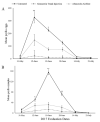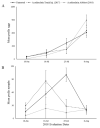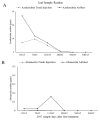Organic Control of Pear Psylla in Pear with Trunk Injection
- PMID: 32972020
- PMCID: PMC7563420
- DOI: 10.3390/insects11090650
Organic Control of Pear Psylla in Pear with Trunk Injection
Abstract
Organic production of pears is challenging in part because OMRI (Organic Materials Review Institute) approved biopesticides are short lived when applied as foliar sprays. Trunk injection is an alternative method of insecticide delivery that may enhance the performance of biopesticides for control of pear psylla. The objective of this study is to compare the efficacy of azadirachtin and abamectin in the control of pear psylla using two different application methods, airblast sprayer and trunk injection. Trunk injections of azadirachtin and abamectin were compared to airblast applications of equal labeled rates on 33-year-old Bartlett Pear trees (Pyrus communis L., var "Bartlett"). The azadirachtin and abamectin trunk injected treatments performed equally or better than the two airblast applications in the control of the pear psylla. The trunk injected trees from the first season provided a moderate level of control into the second season, one year after the injections. This study suggests that trunk injection is a superior delivery system for biopesticides used in organic pear production.
Keywords: abamectin; azadirachtin; pear psylla; trunk injection.
Conflict of interest statement
The authors declare no conflict of interest.
Figures





Similar articles
-
Management of Pear Psylla (Hemiptera: Psyllidae) Using Reflective Plastic Mulch.J Econ Entomol. 2020 Dec 9;113(6):2840-2849. doi: 10.1093/jee/toaa241. J Econ Entomol. 2020. PMID: 33111934
-
Integrated Pest Management Programs for Pear Psylla, Cacopsylla pyricola (Förster) (Hemiptera: Psyllidae), Using Kaolin Clay and Reflective Plastic Mulch.J Econ Entomol. 2022 Oct 12;115(5):1607-1619. doi: 10.1093/jee/toac121. J Econ Entomol. 2022. PMID: 36026531
-
Pear psylla and natural enemy thresholds for successful integrated pest management in pears.J Econ Entomol. 2023 Aug 10;116(4):1249-1260. doi: 10.1093/jee/toad101. J Econ Entomol. 2023. PMID: 37341151 Free PMC article.
-
The Artificial Sweetener, Erythritol, Has Insecticidal Properties Against Pear Psylla (Hemiptera: Psyllidae).J Econ Entomol. 2020 Oct 16;113(5):2293-2299. doi: 10.1093/jee/toaa124. J Econ Entomol. 2020. PMID: 32556301
-
History of IPM in California pears--50 years of pesticide use and the transition to biologically intensive IPM.Pest Manag Sci. 2009 Dec;65(12):1287-92. doi: 10.1002/ps.1865. Pest Manag Sci. 2009. PMID: 19856383 Review.
Cited by
-
Trunk Injection with Insecticides Manages Xylotrechus chinensis (Chevrolat) (Coleoptera: Cerambycidae).Insects. 2022 Nov 30;13(12):1106. doi: 10.3390/insects13121106. Insects. 2022. PMID: 36555016 Free PMC article.
-
Trunk injection delivery of dsRNA for RNAi-based pest control in apple trees.Pest Manag Sci. 2022 Aug;78(8):3528-3533. doi: 10.1002/ps.6993. Epub 2022 Jun 7. Pest Manag Sci. 2022. PMID: 35578562 Free PMC article.
-
Systemic insecticides for control of stem gall wasp in highbush blueberry.J Econ Entomol. 2023 Oct 10;116(5):1737-1749. doi: 10.1093/jee/toad162. J Econ Entomol. 2023. PMID: 37598313 Free PMC article.
References
-
- Horton D.R. Monitoring of pear psylla for pest management decisions and research. Integr. Pest Manag. Rev. 1999;4:1–20. doi: 10.1023/A:1009602513263. - DOI
-
- Westigard P.H., Allen R.B., Gut L.J. Pear psylla: Relationship of early-season nymph densities to honeydew-induced fruit damage on two pear cultivars13. J. Econ. Entomol. 1981;74:532–534. doi: 10.1093/jee/74.5.532. - DOI
-
- Howitt A.J. Common Tree Fruit Pests. Michigan State University Extension; East Lansing, MI, USA: 1993.
-
- Seemüller E., Schneider B. “Candidatus Phytoplasma Mali”, “Candidatus Phytoplasma Pyri” and “Candidatus Phytoplasma Prunorum”, the casual agents of apple proliferation, pear decline and european stone fruit yellows, respectively. Int. J. Syst. Evol. Microbiol. 2004;54:1217–1226. doi: 10.1099/ijs.0.02823-0. - DOI - PubMed
-
- Ing G. Pear production and utilization in North America. Acta Hortic. 2002;8:61–65. doi: 10.17660/ActaHortic.2002.596.3. - DOI
LinkOut - more resources
Full Text Sources

